

|
Home Updates Hydros Cars Engines Contacts Links ←Pit Box 22 Pit Box 24→ Pit Box Index |
|
Pitbox 23 |
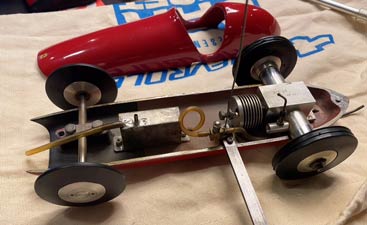 |
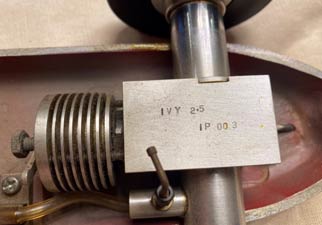 |
| Ivan Prior BRM
In the early 1990s Ivan Prior started
reproducing the entire range of Oliver cars. In
collaboration with John Oliver he also produced a limited
edition of Oliver Jaguar replica twinshaft engines. As a
cheaper alternative Ivan also produced the IVY 2.5 using PAW
internals, which was £110 less than the Jaguar. More
recently there has been a dispute over whether there ever
were any Oliver BRMs ever made, replica or original. So, to
dispel this rumour, here is one of the BRMs Ivan produced, with IVY 2.5 #IP 003. In the last
year a couple of Ivan's replicas have turned up, a Ferrari
and this BRM bearing a spurious Ferrari badge. In addition
another, NIB Ivy motor has emerged (or is it). |
|
 |
 |
| A good idea
at the time? Reducing frontal area
by slicing the lugs off engines was common at one stage, with
some fairly extreme surgery exhibited on many engines. The cars
tended to be purpose built to accommodate the narrower engines,
as with this Swedish example that has a SuperTigre G60 bolted in
to a fabricated pan. Front suspension is a common, semi
independent, system evident on many cars of the period.
Provision has been made for a bridle, but that is as far as it
got, the reasons why, now lost in the mists of time. Does beg
the question as to whether it should be completed with best
guess engineering or left as another of those oddities that turn
up? |
|
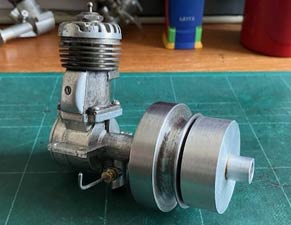 |
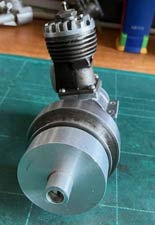 |
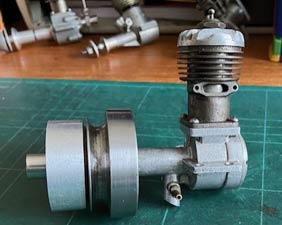 |
| Reeves 6cc The Reeves Model and Precision Engineering company was another of the many, small manufacturers of model engines set up shortly after the end of WW2. Formed by Edward Reeves in Shifnal, Shropshire in 1946, the 6cc engine seen here was the second of the motors produced, available as castings, finished components or a completed motor. Similar to many others at the time, it was essentially a pre-war, spark ignition design that soon gave way to the much higher performance motors being produced. The contact breaker was similar to many other engines being worked by a cam on the back of the prop driver. It is believed that a few engines were produced around 1948 using the newly developed glow plug as in the featured motor. The Reeves engine was only in production for a couple of years with the Company turning its attention to smaller diesels for the next four years before fading from the scene. The full story of the Reeves company and this engine are available on Adrian Duncan's wonderful website. Thanks to Paul Goodall for this item September 2023 |
||
 |
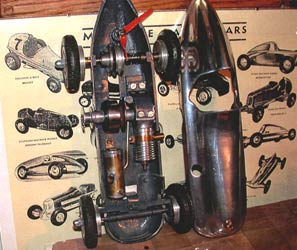 |
| Silberpfeil When an enquiry came in asking if 'we knew anything about this car' the answer was a sort of yes and no. It is a commercially produced car from Germany manufactured by G. Mack in Stuttgart in the 1950s, modelled on the Grand Prix Mercedes Benz. The horizontally mounted RGU 2.6cc diesel is most unusual in having a pull start flywheel outside the car. Wrap the cord round like an outboard motor and then pull, hopefully the engine starts? The engine is connected to the pulley of a clutch on the drive axle via a rubber band. The clutch has an operating lever that sticks out of the rear of the car (red in the photo). The car can be fuelled with the top on and assuming that settings have been established beforehand, wrap the cord round, pull, engine starts, engage clutch and off it goes in a circle if the steering is set. An upmarket 'big boys toy'. The engines coincidently were produced by Ralph Roehner Engineering in Untereichenbach just 3km south of the Kapfenhardt track. Thanks to Amadeus Kurz for detailed information September 2023 |
|
|
|
Nordec Link Of the two Nordec Series 2s that have turned up, both had a standard back plate with a straight venturi. The Woods 10cc had a back plate with an inclined venturi, which now begs the question as to whether North Downs were in the process of developing this new back plate for the Series 2? It does not however explain why a standard R10 would have this, much later, development, unless it was assembled from parts discovered at a later date or intended to see if there was any apparent increase in power? There is a possibility that we are unable to verify that it is actually a Rowell S2 item that has been grafted on. So many questions, no answers as yet. Thanks to John Goodall for this item August 2023 |
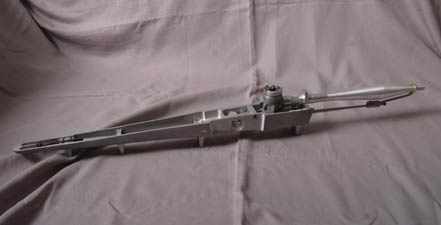 |
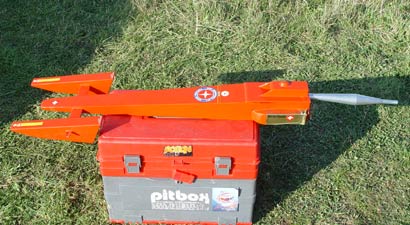 |
| Rear Exhaust oddities
For well over fifty years many commercial
engines have been in rear exhaust configuration as they were
primarily intended for use in planes, but very few that had
removable housings to allow them to be used in a boat or car.
This meant that either the engine had to be turned round with a
great deal of accurate engineering or the exhaust would face the
wrong way. Otto Strobel solved the problem with his OPS using a
U bend that took the pipe over the engine like a large but very
hot handle, others ran the pipe forward towards the front of the
boat or car, while a brave few came up with the solution
illustrated above. Put the motor in the back with the tuned pipe
extended way beyond. That neither of these models were ever
finished indicates that as a design solution it was far from
satisfactory.
|
|
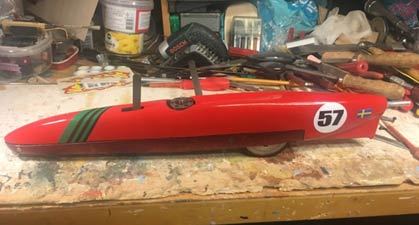 |
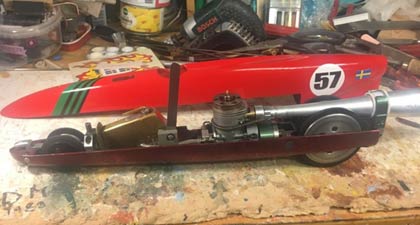 |
| Something of a mystery? This car bears two registration numbers engraved in the pan, one from Switzerland in the 1980s when car registration became compulsory, which fits with the style of the car and a later one from Sweden. Just to confuse things, it also has the same number as another car from a different builder. It has not been possible yet to trace the original owner, or indeed the builder as it is likely that it has made at least three border crossings. Opinion seems to be that it started its life in Bulgaria, but more race records to be searched through before any of the above can be confirmed. Thanks to John Goodall for this item June 2023 |
|
|
|
|
MCA certificates The Model Car Association took on responsibility for administering tethered car racing in the UK until its demise in the late 1950s. Part of their responsibility was ratifying speed records and issuing certificates. With British and Open classes, five distances in each and four capacity classes that was forty possible records to recognise and update. Record distances were 1/4, 1/2, 1 mile, 5 miles and 10 miles. The two certificates here were both for Ernie Bishop, Same date, same class, same distance, same speed. The reason for the two is in the small print, one is a British record, the other an Open record. Thanks to David Giles for these items. May 2023 |
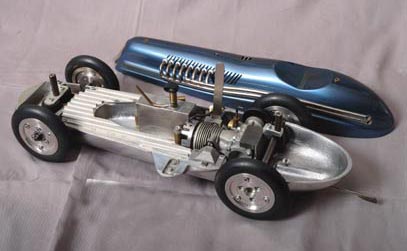 |
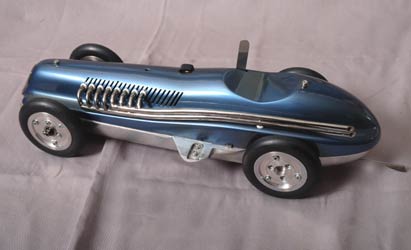 |
| 'Blinged Wilma' The discovery of this car has caused us to question the whole history of the 'Wilma', and even the name. It was originally assumed that this was the work of an enthusiast, but now two almost identical cars have emerged, leading us to conclude that this was a factory built car, but whether for sale or display is not yet known? It now transpires that three different body styles were produced, all to fit the same bottom half. The scale, rear wheels were later replaced by FEMA style wheels for Russian tyres, but both of the cars with the body as above have the larger wheels front and rear. Interestingly, the example here has an eight branch exhaust with two pipes on the left, whilst the other has a six branch manifold on the right with no exhaust pipes. In the west these cars
were referred to as Wilmas, but many are registered as Wilnius,
the westernised spelling of the Lithuanian capital where they
were produced. Original parts from the same source are clearly
etched Vilma, which is certainly the derivation of the name they
are more commonly known by and possibly a contraction of Vilnius
made/manufactured? The
full Wilma story |
|
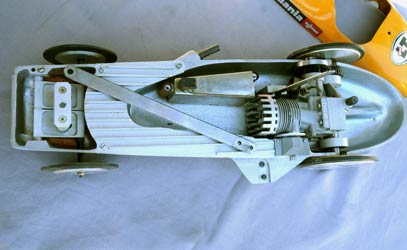 |
 |
| Wilma
This pristine and un-run car is completely
original and represents the only, mass produced, ready to run
tethered car. Produced in volume in Lithuania by Edvard Stelling
under the Wilma name that he used for products prior to the
break up of the Eastern Bloc. As can be seen, the car used a
standard MAC 3.5cc motor with the exhaust being routed through a
resonant chamber cast into the chassis pan and trailing front
suspension with rubber bushes. With no controls on the class, it
was not long before the resonant chambers were machined out and
normal tuned pipes fitted, front suspension turned round to
extend the wheelbase or even extended beyond the front of the
car and the MAC motor ditched for something
more potent. The Wilma became outclassed by purpose built and
ever more exotic cars, resulting in a number of unmolested and
basic versions still turning up.
|
|
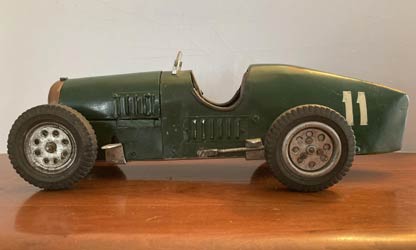 |
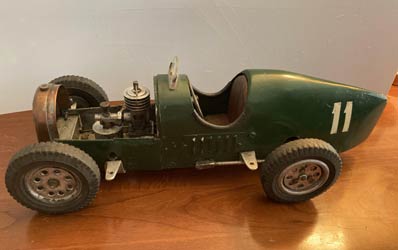 |
|
Not a Wasp This car bears a striking resemblance to a M&E Wasp, which was probably the basis for the building of this very similar model? The tyres and wheel hubs are M&E although the hubs have been modified. The 2cc ED engine from 1948 is slightly later than the Penny Slot more normally seen, and the builder has been able to get the compression screw beneath the bonnet. The Wasp had a steerable rear axle, but this version has a gearbox of some sort, along with radius rods to keep the axle in line. The most obvious visual difference is the longer, sloping and curved tail, which gives it a more scale appearance, so not a Wasp, but almost certainly influenced by one. Thanks to the owner of the car for the photos and allowing us to share this delightful model February 2023 |
|
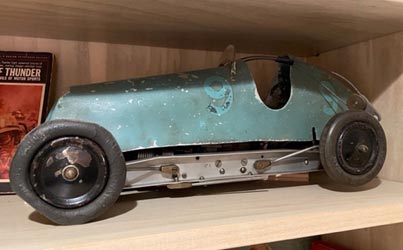 |
Electra 2A Sid Smith of Electra Pioneer, down in Chatham produced a chassis kit for the famous Gerry Buck 2A car. The chassis rails were complex pressings being tapered at both ends and splayed apart at the front. A few of these cars have appeared over the years, but two exact replicas, including the original body style have confused buyers who thought that they had the original car. The ignition switch pivots from the bottom of the chassis and can be seen just below the radius arms. Thanks to the owner for photos January 2023 |
©copyrightOTW2023